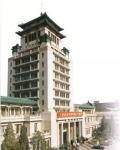- Latest Archaeology Updates
- Importance and applicability
- Famous Archaeologists
- Museums Collections
- Site Map
- World Heritage Sites
- World History Monuments
- Archaeological Organizations
- World Atlas of Archaeology
- Forensic Investigation and Geophysics
- Contact Us
- Movies based on Archaeology
- Frequently Asked Questions
- Archaeological discoveries
- Tell a Friend
- Archaeological Abbreviations
- Gallery Collections
- Famous-Museums site map
- Famous-archaeologists site map
- Archaeological Monuments site map
The Palace Museum was constructed based on a symmetrical layout. The palace complex is divided into two main sections: the Outer Court, where the emperor conducted ceremonies and met with officials, and the Inner Court, where the emperor, empress, and their entourage lived. The palace complex consists of 980 buildings and 8,886 rooms, with courtyards, gardens, and gates scattered throughout. The Hall of Supreme Harmony, located in the center of the Outer Court, is the most important building of the palace complex. It was used for important ceremonies such as the emperor’s enthronement, imperial weddings, and state receptions. The Forbidden City is known for its grand architecture and spectacular decorations. Its walls are made of a special type of brick that is said to be able to withstand earthquakes. The roofs of the buildings are decorated with intricate designs and are often made of glazed tiles that shimmer in the sunlight. The walls of the palace are decorated with detailed murals and calligraphy, and the interiors are adorned with elaborate furniture and decorations. The palace also houses a large number of artifacts from past dynasties.
The Palace Museum, formerly known as the Forbidden City, is a cultural heritage site located in the heart of Beijing, China. It is the world’s largest palace complex, with an area of over 720,000 square meters and over 9,000 rooms. It was the residence of the emperors of the Ming and Qing dynasties for nearly 500 years. Built in 1420, the palace was the political center of the Chinese government for almost 500 years. The Forbidden City was declared a UNESCO World Heritage Site in 1987 and is now one of the most visited tourist sites in China. The Palace Museum is home to a large collection of Chinese art and artifacts, including ancient bronzes, ceramics, paintings, and calligraphy. It is also home to the world’s largest collection of ancient Chinese books, including the earliest known editions of Confucian classics. The museum houses an impressive collection of ancient weapons, including swords, spears, and crossbows. The Palace Museum also has an extensive library, which contains over one million volumes. It is also home to the Imperial Academy, a research institute devoted to the study of Chinese culture and history. The Palace Museum is a must-see destination for anyone interested in Chinese culture and history. Its grand architecture, magnificent decorations, and extensive collection of artifacts are sure to fascinate visitors of all ages. The museum is open to the public and offers guided tours in several languages. A visit to the Palace Museum is sure to be a memorable experience.

